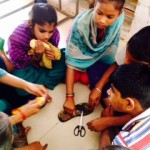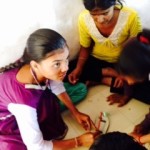The whoops of joy bring the assistant principal running into the classroom.
I am visiting a science workshop organized by Pratham in a government school in Ahmadabad, Gujarat. Four groups of 7th-graders are clustered on the floor. In the center of each, there are a few materials: the unused sole of a chappal (the most common footwear in India, flip flops made entirely out of rubber); six small magnets; a pencil; piece of a cut-up floppy disk. The task: create a bullet train.

There is a revolution going on from pre-schools to universities on how best to prepare students for the 21st century. The fundamental shift seems to be from “teaching” to “helping students learn.” Whether its teaching physics at Harvard University or basic science to underprivileged children in India, the approach is the same: stop teachers from reading out from a textbook (aka a lecture at Harvard), and get the students on the floor, getting their hands dirty and solving a problem together.
The approach goes by several names: active learning, “upside down” teaching, “flipped classroom” (the latter two monikers because the students are learning from the activity and from each other, with the teacher merely as a facilitator). Western educators embraced it decades ago. What I’m observing in the Pratham classroom bears witness to what Eric Mazur, professor of physics at Harvard, says are its benefits.

First, says Mazur, active learning “erases the gender gap”. The 7th graders in front of me are divided equally between girls and boys, and the girls are as vocal and hands on as the boys.
Second, there is “better retention of knowledge”. While I cannot attest to that in an hour visit, certainly the fact that each student has seen magnetic force in action and has to explain how ‘the train’ works, is going to stay with them much longer than hearing about it from a teacher’s mouth.
Third, according to Mazur, this approach creates budding scientists, a field in dire short supply the world over. And indeed, the excitement in the Pratham classroom is palpable. One group finishes well before the others and after the initial whooping, it quickly disperses with members joining the other groups and explaining how they achieved success. I worry that the other groups will lose interest since the drive to be first is over, but no, they redouble their focus and persevere.

All this is even more remarkable given the context. Government schools in India seem to exist at the bottom of the education hierarchy, with meager resources, overburdened teachers, and rote learning as the default teaching method. The children around me come from a community of daily wage laborers. Nothing in their experience would remotely enable them to imagine a speeding train powered by magnetic levitation. Pratham had to first convince the community and then the school that letting their kids play and create is a better way of teaching science than reading about it in a book.
Finally all four trains are up and running, and there is a palpable sense of collective achievement in the room. A young girl and I gaze at the delicately quivering pencil, held midair by an invisible yet undeniable force. Someday, I say to her, I want to come back and ride from here to Mumbai in a train you have built. “Barabar”, she says. Absolutely.
Read another article about Sarita’s work with Pratham.
This blog was originally published on Pratham USA.
